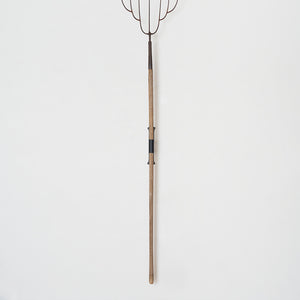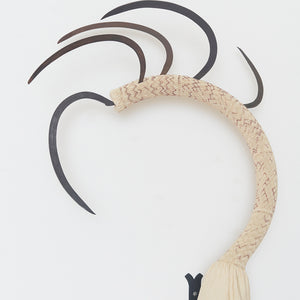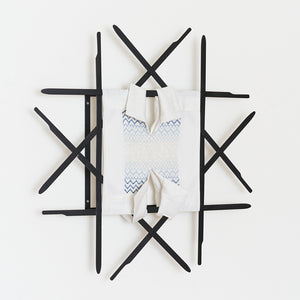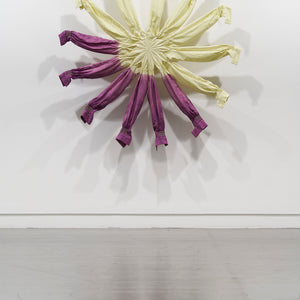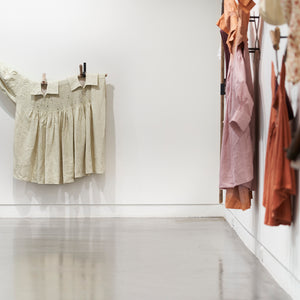THE BECKONING BLADE
21 July to 20 August 2022
Artist Statement
The Beckoning Blade is my love letter to folk horror and in particular Robin Hardy’s 1973 film The Wicker Man. The Wicker Man has long been influential in my practice but in this exhibition it comes to the fore, lending its peculiar air of exuberance, eeriness, and mischievous humour to the work.
While many definitions have been offered for the folk horror genre since the landmark ‘unholy trinity’ of films Witchfinder General (1968), The Blood on Satan’s Claw (1971), and The Wicker Man, it has remained elusive and given to reinvention and reimagining against different backdrops. Conjured from root and rot, bone and blood, lurking in the fields, the forests and the furrows, folk horror is the antidote to the pastoral idyll. It manifests in lingering ghosts excised from the soil, the unearthing of suppressed forces in peaceful settings, or in the words of Robert Macfarlane, as “the skull beneath the skin of the countryside”. Unwary visitors to isolated communities get more than they bargained for, and relics and ruins release their dark power. At its core, folk horror could be described as a genre in which folkloric and pre-Christian traditions conjoin violently with horror tropes, and in which landscape, isolation, and sacrificial forces take centre stage.
The mutability of folk horror makes it ripe for interpretation and open to new contexts. My interest in the subject leans less toward the landscape, and more toward the objects that literally connect to the land and the rituals and beliefs that underpin this connection. It is less about the individual protagonists who populate folk horror stories, than the garments and articles that might allude to them.
With a palette derived from The Wicker Man’s kaleidoscopic May Day procession and Ari Aster’s blindingly bright 2019 film Midsommar, this body of work leans into danger and disquiet through repeated use of modified scythes, sickles, blades, and an English garment known as a smock. The smock, a handmade linen outer garment traditionally worn by agricultural labourers, has associations with romantic ideas of a simpler life and a ‘back to nature’ ethos, concepts that are often challenged in folk horror films and literature. Within the exhibition, the smock also acts as a figure or character – evoking scarecrow and body – and a means to set the stage for sacrifice.
What excites me is the darkness already present in folklore, and the way it so comfortably nestles alongside horror. With a silent twist of the blade, an apparently quaint custom can suddenly become menacing, and objects or rituals a form of entrapment. Herein lies the appeal of folk horror for me: in its inherent tension between celebration and threat. The outwardly welcoming communities that come together to celebrate the Summer Solstice, Autumnal Equinox or a prosperous harvest are the very people who may turn on the naïve outsider.
For me, creating work is a means of personal myth making. This show extends an invitation to participate in my folk horror narrative, wherein the part of the unsuspecting outsider who becomes the ultimate sacrifice, is here transferred to you.
Acknowledgments
My heartfelt thanks to everyone who helped make this show possible. I could not have done it without the care, support, encouragement, and contribution of the following people: my family; my fellow artists at Switchboard Studios, in particular Cheryl Hutchens, Bernadette Klavins, Caitlin Bowe, Anna Horne and Jess Mara; James Dodd; Sean Williams; Damien Warman; Sam Roberts; Leigh Robb; Andrew Purvis; Jo Kitto; Richard Lewer; and the wonderful team at Hugo Michell Gallery: Hugo Michell, Ceridwen Ahern, Jenna Pippett, and Gabi Lane.
A very special thank you to all the friends, family and well-wishers who donated, tracked down and sourced embroidered floral handkerchiefs for me – approximately 200 pieces have been stitched lovingly into the show. A big shout out to the Fabric Store, The Drapery, and Ferrier Fabrics for feeding my linen habit.
Last, but by no means least, thank you to my dear Roy Ananda for your unwavering support, love, and belief in me.
This exhibition has been generously supported by the Australian Government through Arts South Australia, 2022.








